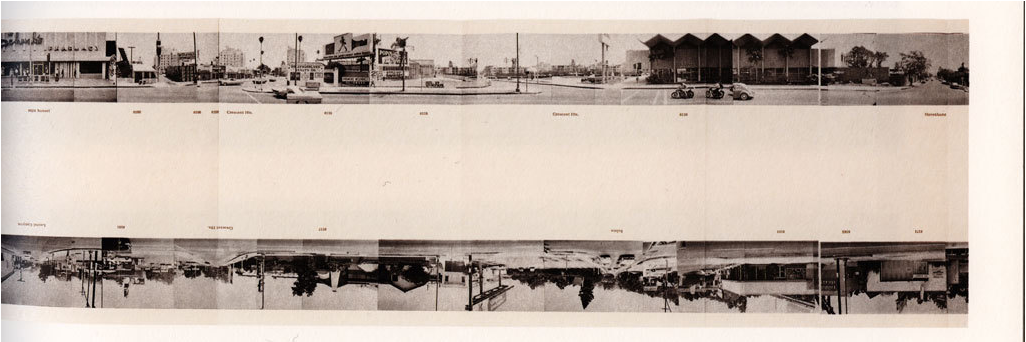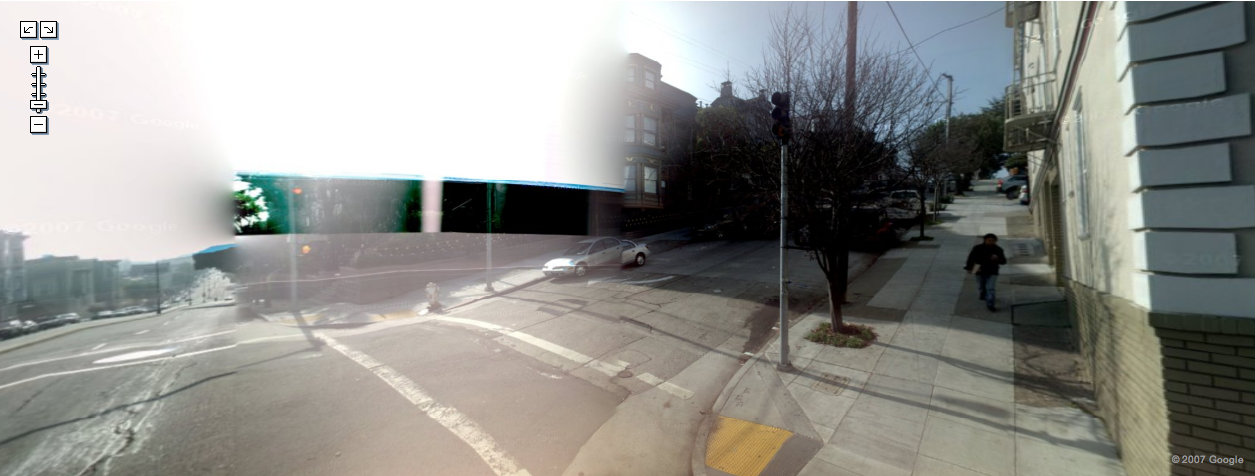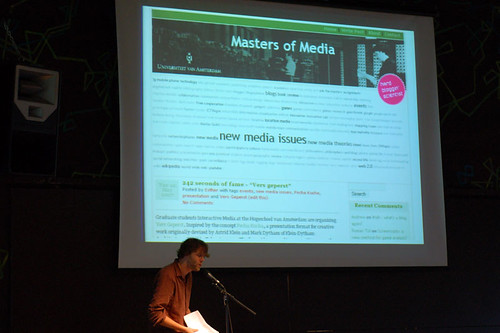New Network Theory – Florian Cramer
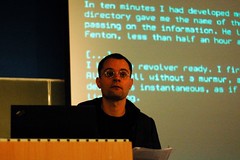 Today’s final speaker is Florian Cramer of the Piet Zwart Institute, who has a nicely low-key website. Florian’s work deals with text, code and aesthetics – one piece of his is the extended essay, Words Made Flesh: Code, Culture, Imagination, which is a kind of alternative history of code. His presentation here is about Text and Networks.
Today’s final speaker is Florian Cramer of the Piet Zwart Institute, who has a nicely low-key website. Florian’s work deals with text, code and aesthetics – one piece of his is the extended essay, Words Made Flesh: Code, Culture, Imagination, which is a kind of alternative history of code. His presentation here is about Text and Networks.
Florian asks, what is the effect of having the metaphor of the network at the center of new media studies? That is, metaphors can come to act like maps or models, making some lines of inquiry more amenable while closing others off. To answer this, Florian takes us back a little and addresses the relationship between the words network and text. Etymologically, there is little difference, as text is closely aligned with the word ‘web’ (it comes from ‘textus’, basically meaning ‘something woven’).
He notes how conceptions of text have changed over time, and asks how a term like hypertext affects our understanding of it. Via Borges’ Garden of Forking Paths, and contra hypertext theorist Stuart Moulthrop, he argues that since text itself contains hyperstructure (its paradigmatic, or associative links), the term hypertext is actually redundant.
There is also the issue of how practice influences this. Florian says regular computer users have no problem understanding what text is. It is simply an amount of discrete (in most cases alphanumeric) symbols. And bringing meaning into it, users know that 1) syntax is that which is fully computable and 2) semantics is computable only as syntax.
So again, what happens when we make the network the emblem for current complexity? We should be careful, Florian says, not to assume a new network theory is one that has progressed beyond its roots in systems theory. Also, there is the danger of favoring the network, in assuming it is something positive only because it is the object of study.
With that in mind, we move on to Friday morning’s speakers – ironically enough, three premiere network theorists.
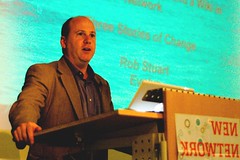 Rob Stuart is an activist based in Philadelphia. Here he gave an overview of some of his work, especially that which made use of new technologies. In this way he gave conference-goers some network practice to go along with the theory.
Rob Stuart is an activist based in Philadelphia. Here he gave an overview of some of his work, especially that which made use of new technologies. In this way he gave conference-goers some network practice to go along with the theory.
His first case study drew comparisons between the railroad and the new media network. Railroad operators have traditionally been able to lay down the law, enabling movement for some while restricting that of others. An affordance of the new networks, on the other hand, is citizen action. A meeting between old and new occurred in Philadelphia, when railroad companies attempted to close off the Schuylkill River Park Trail.
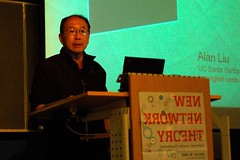 Can Network knowledge improve? The second New Network Theory session starts with this question from Alan Liu in his presentation Network Knowledge: Policing Web 2.0.
Can Network knowledge improve? The second New Network Theory session starts with this question from Alan Liu in his presentation Network Knowledge: Policing Web 2.0.
Alan’s aim today is to present a draft proposal for a non-reactionary policy for regulating and improving Web 2.0 knowledge. In doing so, he’s opening up the can of worms that is the Wikipedia debate.
(Read more and discuss below..)
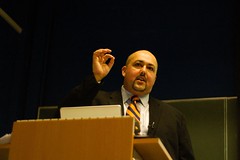 Siva Vaidhyanathan, author of The Anarchist in the Library: How the Clash between Freedom and Control is Hacking the Real World and Crashing the System and currently associate professor at NYU, is here to talk about the Googlization of Everything.
Siva Vaidhyanathan, author of The Anarchist in the Library: How the Clash between Freedom and Control is Hacking the Real World and Crashing the System and currently associate professor at NYU, is here to talk about the Googlization of Everything.
Siva’s starting point is that Google is part of our lives, and we talk about in a way that resembles the way we would talk about the Divine. Ultimately, we say, “It is a force for good.” As per the Book of Sergey and Larry, “Don’t be evil”. And in Siva’s words, the path to heaven seems lined by small, personalized advertisements. In the world of Google, moral problems are merely unsolved technological ones. But Google – the search engine – is a black box, and perhaps this is why we mere mortals must become believers.
Google has divine aims, too. Universal access to all of the world’s information? Sergey says, “It would be like the Mind of God”.
The Masters of Media are at the New Network Theory Conference – organized by Network Cultures, ASCA and the Media Studies department at the University of Amsterdam (that’s us!).
Geert Lovink introduced the program as an ambitious attempt to reinvent network theory – a post-Castellsian theory, if you will – before Jan Simons gave a brief history of ASCA the Media Studies department. And now we’re off…
We will be trying to cover as much as possible, so check back often.

Peter Fischli and David Weiss made a kinetic artwork in 1987, called Der Lauf der Dinge. [Medien Kunst Netz]
My mother was very sensitive and would show this to me and my brother instead of Bambi. I still have good memories. Lately I have been looking for (digital) remediations of this work of art and I found a couple of very interesting ones. (and many not so interesting ones)
More interesting ones (to me) are:
Ass kicking device (Made in HL2 Garry’s mod) and The Oblivion Domino Day (made with the game Oblivion)
The Honda ‘Cog’ commercial (Wieden + Kennedy 2003)
Die Lauf der Data, a project from Jonas Hielscher for the School of Arts, Utrecht (2007)
NHK’s “Pitagora-Switch”, originally aired for Japanese children on public TV
The new HEMA website
Also, Fischli and Weiss is most connected with Rube Goldberg.
And the Blue ball machines Roman Tol mentioned earlier
Isn’t it nice when things just (don’t) work?
danah boyd recently wrote an interesting article on “viewing American class divisions through Facebook and MySpace.” She points out that class divisions have emerged and are being played out through aesthetics in Facebook and MySpace. I think this is one of the most interesting points in the article because I tend to “judge” the quality of social networking sites and the people on them just based on the looks of the site. I prefer Facebook and LinkedIn over MySpace and Hyves because of their clean aesthetic looks. The extremely messy look of MySpace and Hyves and it’s abundant use of smileys and animated gifs make the sites look “cheap and unprofessional” to me. I tend to see Facebook and Linked as professional sites because of their clean, elegant and crisp looks.
Do you also judge sites by their looks? Do aesthetics influence your choice in joining a social networking site?
Why do I feel a need to blog daily? There seems to be some kind of consensus or norm in the blogosphere that blogs should be updated daily. Several blogs about blogging recommend posting daily and blog search engine Technorati’s rankings are correlated to a blog its freshness. There is both an internal and an external “perceived freshness fetish” (Rogers, 2007) in the blogosphere. The internal freshness fetish could be described as a wish, a personal demand or a wanting to blog daily. The external freshness fetish could be described as a requirement by external parties like Google and Technorati to blog daily to achieve a certain ranking. This external freshness fetish is further imposed by using ping techniques to let services such as Technorati know that you have updated your blog.
Personalized advertisments are not enough. Google boss Eric Schmidt says, “Google is not at all done with your information problems. There are many, many examples of where it would be nice if Google had more of an ability to understand time and choices.”
So maybe we can make some recommendations before Google makes them for us. What problems would you like the company to solve?
More from the article:
The more a search engine can learn about a user’s surfing habits, the better it can predict their intent.
With more web history data, Google could offer users a “hyper-personal” experience, with results based on potentially years’ worth of pattern analysis of a user’s search history.
Speaking about the long-term aspirations for Google, Eric Schmidt, the firm’s chief executive, said one day the search engine could potentially answer questions such as “What shall I do tomorrow?” and “Which college should I go to?”.
Surely Schmidt knows it is a little disingenuous when he says, “The important principle, and I want to say this over and over again, is that this is opt-in, user choice.” What kind of choice would that be? What doors will close when I opt out of a grand scheme like that?
Anyways.. I would like Google to remedy my compulsion to watch the chipmunk video over and over. (And related to this, I could use a little help on my term papers, too.)
Partly in response to that stumper from a while back, ‘What’s a blog?’, this is another: What is interactivity?
I’ll start with the top result from a “define: interactivity” google query:
If your Web site is not interactive, it’s dead.
I really like this definition. It gives a sense of urgency – as in, “I want my website to be alive!” – without really saying anything. With its knowing inadequacy, the definition serves as a reminder that I don’t just want an interactive website, but also an interactive phone, an interactive television and of course – with every reference book I buy – a ‘free interactive CD-ROM’. The list goes on: I prefer interactivity when it comes to education, to politics, and to my social life. And more than anything else in this world, I really want an interactive pet robot.
I received this message from dr Eric McLuhan:
Dear Miss van der Klink,
I have just returned from speaking at a convention in Mexico City. The
students at the university there became somewhat excited about some work of mine and posted the essay on the convention web-site. As a result I have
decided to simply give this particular piece of research to the world. It
is a major discovery in the field of art, and in particular in the field of ancient Egyptian art.
Here is the URL: www.media-ecology.org.mx
Please have a look at the piece, and, if you think it is worthy, please
send it–or the URL–along to all of the artists that you know. I wish
particularly that it get in the hands of artists (who can use the technique
discovered 4500 years ago, and which I rediscovered) and students.
Best regards,
Eric
 I recently worked at a friend’s house and I was trying to connect to their wireless networked called “GORGONZOLA.” I thought that was a pretty funny name until I noticed the names some neighbors had given their networks. One was called PAKISTAN and another was called Jesus Christus is Heer (Jesus Christus is Lord) which made me laugh out loud (OK it actually it made me LOL.) I had previously imagined a network names flame where one neighbor would name their network something provocative and another neighbor would respond to this with an even more provocative name. I wonder if this happened in this neighborhood (notice: pretty good protected neigborhood).
I recently worked at a friend’s house and I was trying to connect to their wireless networked called “GORGONZOLA.” I thought that was a pretty funny name until I noticed the names some neighbors had given their networks. One was called PAKISTAN and another was called Jesus Christus is Heer (Jesus Christus is Lord) which made me laugh out loud (OK it actually it made me LOL.) I had previously imagined a network names flame where one neighbor would name their network something provocative and another neighbor would respond to this with an even more provocative name. I wonder if this happened in this neighborhood (notice: pretty good protected neigborhood).
I remember feeling completely lost in my first-year philosophy course – the feeling never really goes away – and wanting some kind of map of the territory or overview . This tool maps philosophers’ influences, and while users can’t update the influences, the author suggests that could happen in the future. (Also neat, rolling over a name gives a short introduction.) A view from Foucault: 
In 1965, Ed Ruscha photographed Every Building on the Sunset Strip, in a way that may sound familiar to those following the Google Streetview release:
Ed Ruscha took the photographs contained in this leporello with a motorized Nikon camera mounted to the back of a pick-up truck. This allowed him to photograph every house on the Sunset Strip while driving – first down one side of the street and then the other. The pictures were then pasted in order, and the individual buildings were labeled with their respective house numbers.
There is so much to say about Streetview, luckily most of it does not involve any of the weird captures that have been all the rage lately (rivaling Loltheorists? no, but still pretty big). Then again, what seems so fascinating about Streetview is exactly its ‘Hey, look at this!’ value – even for relatively boring photographs – the same thing that keeps us uploading digital photos by the bucket to sharing sites like Flickr.
So I was browsing this fantastic cat picture site when I found delicious links to similar projects, such as this one on presidents and more importantly, this one on theorists.
It features Deleuze, Foucault, even Henry Jenkins. He caught wind of the site and commented on it in his blog:
And to my astonishment, yours truly has become a favorite target in this new academic pass-time. My students have long considered my face an icon upon which they can test their emerging mash-up and remixing skills so I am delighted to see these practices extended into the culture at large. Anything which will further the cause of participatory culture.
Click (more…) for some of my favourites
 As I was playing Zelda: A Link to the Past today on my SNES emulator, something struck me: I had an in-game deja-vu. A feeling as if I had been there before. My mind quickly tried to scan all the options and I found out that I have really vivid memories of various computer games. These experiences are basically stories I could tell to my friends and family at a party. As cognitive psychologist Jerome Bruner mentioned in his interesting essay Life as Narrative: all our experiences are in some way structured as narratives, and we remember and learn from these narratives in the future.
As I was playing Zelda: A Link to the Past today on my SNES emulator, something struck me: I had an in-game deja-vu. A feeling as if I had been there before. My mind quickly tried to scan all the options and I found out that I have really vivid memories of various computer games. These experiences are basically stories I could tell to my friends and family at a party. As cognitive psychologist Jerome Bruner mentioned in his interesting essay Life as Narrative: all our experiences are in some way structured as narratives, and we remember and learn from these narratives in the future.
Twan did a great job presenting our blog at the first edition of Vers Geperst at Club 11 in Amsterdam. A New Media student from Utrecht from the audience contacted us afterwards to talk about the blog and New Media. Other great presentations included Michael Stevenson – the Whatever Button and Erik Borra – Open Search.
 On
On
The police were able to find proof the computer once contained child pornography with the use of a keylogger. A keylogger is an illegal spyware application that saves the keyboard actions of the user. A keylogger is installed without the knowledge of the user by means of a virus or a software package containing spyware. A keylogger is walware and for that reason against the law.
Just for the record, I am 100% against any forms of illegal pornography and am very pleased Catterson is charged. Yet, I am not completely sure the actions taken by the police are proper. If a keylogger is illegal then it is not right when authorities make use of it, even if the cause is just. I assume the walware was installed before the police confiscated Cattersons computer, still, I recon the use of it is questionable and perhaps even illegitimate. What if in the future someone gets arrested on milder charges, say possession of Spiderman 3 in divx format: is the police allowed to use spyware to gather evidence?
I recon the British police did not put the keylogger records forward as evidence, but used it to force the suspect to confess, still this may lead to further breaches of privacy; following this logic governmental authorities may distribute walware and use it, as long if it is not put forward as proof but used as a means to pressure suspects.
Luckily I saw Spiderman 3 in the cinema… actually let me rephrase that…. sadly I saw Spiderman 3 in the cinema… I wasted 10 euro’s on a terrible movie.

A while ago I found this flyer tied to my bike with a rubber band. First I was astonished, then it made me laugh. I have grown up in a small town in the Netherlands and of course quite often I have found flyers at the windscreen of my car, but this analog spamming phenomenon in Amsterdam was new to me. Most people in Amsterdam do not have a car, because it is impossible to park your car anywhere in the city. Therefore (small) companies have found new ways to reach their target group (in this case students and/ or people in their twenties, because the flyer is a advertisement for a party).
Graduate students Interactive Media at the Hogeschool van Amsterdam are organizing Vers Geperst. Inspired by the concept Pecha Kucha, a presentation format for creative work originally devised by Astrid Klein and Mark Dytham of Klein-Dytham Architecture (KDa) in Tokyo in 2003. The format has spread to many cities across the world.
Vers Geperst is an informal gathering that offers young creatives a chance to present their finest work and inspire the audience. The Dutch term ´Vers Geperst´ roughly translates as freshly squeezed. But it also stands for a creative event with a strict presentation format, in which participants have only six minutes each to present their ideas to the audience. So no long-winded speeches, but a series of quick and sharp presentations. This Vers Geperst Night, which will take place in 11 (the club in Amsterdam), focuses on the youngest generation of creative designers. Young creative professionals as well as graduation students are invited to present their work. After the presentations, there will be plenty of time to mingle with the audience, which will also include a few scouts from creative companies and cultural institutions.
The MoM blog will be presented at this event in 242 seconds :-)
Date & Location: 29th of May, 11. Amsterdam
Time: Doors open at 7:30 PM (19:30). Event starts at 8:00 PM (20:00)
DJ: My Little Soundsystem
At the moment I am writing a paper for the tutorial “current themes in new media”. In this paper I am analyzing whether Fraps, a real-time video/ screen capture software program, is an appropriate tool to use to collect data for game research. In this paper it is my objective to see if new methods can be found in the field of game research that can replace old methods for data gathering in the humanities department.
As many game researchers have argued, for example Aarseth and Yee, that in the past games have been researched through various disciplines. Psychologists research if children behave aggressively in real life after playing a violent game and economists research the influence of ingame economies on real-life economies, etc.. Game studies are a very young discipline, so it needs its own methodologies, claims Espen Aarseth. Ian Bogost does a wonderful job in his book “Unit Operations. (A great review of this book can be found here). Bogost comes up with an excellent new way of researching games, by mixing computation, literary studies and philosophy.
I would like to step away from methodology and have a look at method. Since games are digital and interactive, other methods may be more suitable for data gathering where the interaction of a player with the selected game is being researched, than qualitative methods such as observation and interviews.
In an ongoing discussion on a forum I got into a scuffle with a formidable opponent about what blogs exactly are. I tried parroting all that I had been taught in various classes during the BA and MA courses in New Media; basically that weblogs are a form (as argued by Albert Benschop in class at one point) and not a function. I agreed with wikipedia’s initial definition that, whatever blogs are, they must have this fundamental characteristic:
“A blog (short for web log) is a website where entries are made and displayed in a reverse chronological order”
In a rebuttal, my adversary made points about the necessity for blogs to be written in an explicitly personal manner, and that the more people collaborate on a blog, the less “bloggy” it becomes and the more it starts to be a part of some generic “online media”. I tried to refute these points by listing blogs that are not overly personal (Engadget), blogs that have a legion of contributers (Huffington Post) and academic blogs (such as ours, or Terra Nova) which can be both.
 Room F201C of the University of Amsterdam’s Oudemanhuispoort building for an hour was the domain of Fiona Raby. She presented her ideas on design, which has close links to the design practice of Anthony Dunne, together they’re also known as the duo Dunne & Raby. It is a vision on design that is not of technological futuristic visions, but of the fragile people, but still not pessimistic and depressing, but optimistic. Below is my account of the presentation.
Room F201C of the University of Amsterdam’s Oudemanhuispoort building for an hour was the domain of Fiona Raby. She presented her ideas on design, which has close links to the design practice of Anthony Dunne, together they’re also known as the duo Dunne & Raby. It is a vision on design that is not of technological futuristic visions, but of the fragile people, but still not pessimistic and depressing, but optimistic. Below is my account of the presentation.







